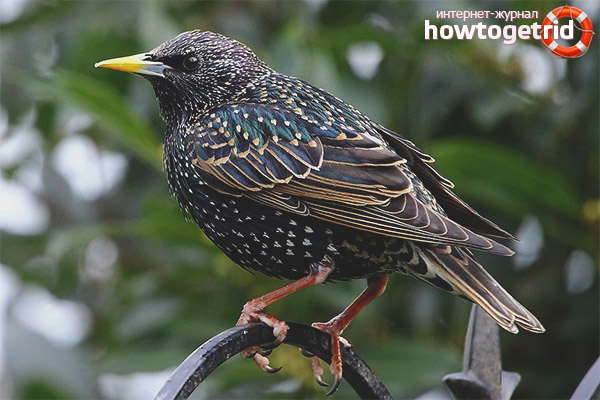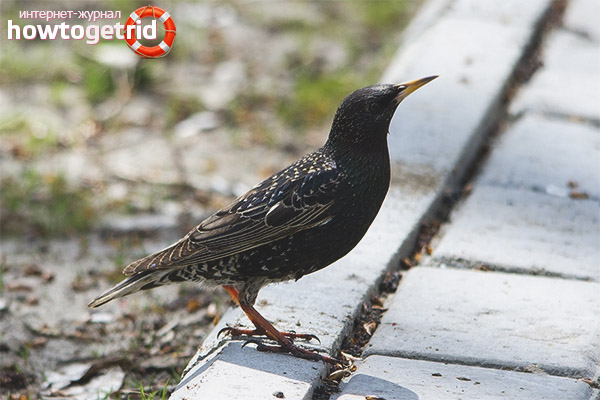The content of the article
An ordinary starling is one of the most unusual birds belonging to the order Passeriformes. Zoologists named them because of the singing, since it shows a "squash". Birds are easily able to adapt to any weather conditions. They also have unpretentiousness in food, due to which over the past half century their population has almost doubled. In different habitats, birds are classified into several species of common starling with slight differences, but basically they are not much different.
The appearance of the starling
The structure of the skeleton and the number of feathers on the body strongly resembles the appearance of a blackbird, however, starlings are much smaller and the method of movement is different (starlings just walk, like pigeons, and blackbirds jump, like most of the sparrow squad). The body length of an adult bird ranges from 18 to 22 centimeters, and weight - 50-80 grams. The wings are in the shape of a birch leaf, that is, at the beginning wide, but at the end much narrower. The younger the starling, the rounder their shape. The tail reaches a length of up to 7 centimeters, and the legs are bright brick in color. The wingspan reaches forty centimeters.
Differences between the appearance of the female and male in the length of the feathers on the chest and the presence of spots: in females the feathers are shorter and there is no bluish spot at the beginning of the beak. Instead of a blue spot, they have small red dots. In birds of both sexes, the beak is the same length, sharpness and slight curvature.
The color of feathers in all individuals is blue-black with a special shine; in different species, it can be cast either with ocher, or with eggplant, or malachite, or cornflower blue. With the onset of cooling, the plumage changes slightly and becomes covered with whitish spots, which are most on the wings and breast. This color stays all winter, but with the onset of spring, when it comes time to change feathers, it becomes dark brown.
How do starlings nest and breed?
Before the mating season, birds are divided in pairs. If they are not old enough, they create nests, but do not lay eggs, but leave them as a permanent place to sleep.
The male is engaged in the search for a place, choosing the most spacious nest, or taking the places of falcons or eagles. After that, he begins to whistle, thereby “causing” the females. Ready for nesting birds create the most comfortable places for laying eggs. For their construction, they use holes in tree trunks, mountain gorges. If starlings live in the city, then they choose as a "home" the space under the roofs of houses. The nightingale's nest resembles a cup and is built from dried leaves, twigs and tree bark with both birds.
For greater softness, the inner surface of the bird is covered with moss, fur feathers, grass. The female lays one egg each day and tries to incubate them as much as possible. After the hatching of the chicks, the female and the male constantly fly in turn from the nest for the extraction of worms and beetles. Their number ranges from 100 to 300 pieces. In less than a month, the chicks fully grow and fledge.
In the north, the egg-laying period begins in March, and on the opposite side of the planet, it starts from September until the early start of winter. Thus, the female produces offspring about three times.
Interestingly, the males are not monogamous, that is, they choose one female for the breeding season, but the next season they choose another.
Basically, a bird lays from four to seven eggs of pastel blue color, and their weight is 5-7 grams. They incubate for two weeks.
Where do ordinary starlings live?
Their habitat is distributed over all climatic zones, except for Central and South America. Even on the mainland (Australia, Africa) they have been living since the nineteenth century. Due to the unpretentiousness of the living conditions, starlings adapted to life in hot countries.
Those birds, which are in the southern and western strip of the European part, do not fly to warmer climes, and in colder zones when the cold weather sets in, they fly to the south (India, Cambodia, Morocco). Often, the flight range can reach two thousand kilometers.
Return from the south occurs in early spring, and in northern species - in early spring. Moreover, males first fly out, and after a few days - males. The habitat of field species are swamps, plains, fields, coastal soils of lakes and rivers.
What does it eat?
In order to find food, birds go around the soil or inspect trees for insects. Their nutrition is completely dependent on the subspecies and species of insects in the area in which they live. It mainly consists of seeds and fruits of plants, field crickets, ants, bugs, caterpillars, butterflies. Birds like to visit summer gardens for the sake of fruits and berries. They show great interest in grapes. If the birds live in megacities, then they feed on what the townspeople leave in specially made feeders, but sometimes fly out of it if there is no food. In March and April, their main food is insects (millipedes, crickets, larvae and worms).
Their main delicacy is various crops, currants, strawberries, raspberries, apples, pears, apricots. Due to the shape and sharpness of the beak, birds are able to crush bones and nuts.
Entertaining facts
- Starlings perfectly imitate the sources of other sounds. They can not only show their own voice, but also make it look like a phone ringing, croaking toads, creaking, rattling, chattering grasshoppers, the barking of dogs.
- Flocks of starlings can be so large that when they are on a tree they can break branches.
- Starlings are not only pests in cities and summer cottages, but also useful birds in some places. Sometimes people specially build improved houses for them, so that they help them in the fight against insect pests.
- In Kazakhstan, Georgia, and the United Kingdom, the bird population has declined significantly. This happened due to the fact that there was reduced the amount of land for cows and sheep.
- The population of some countries calls these birds “cracklings”, which means fried pieces of bacon.
- Often they are confused with thrushes during the mating season, since it was at this time that their beak became bright yellow.
- Starlings are always in great danger. They can die from the clutches of peregrine falcons, eagles, crows and other birds of prey. Also, their nests can be ravaged by wolves, foxes, dogs, they are attracted to small chicks and eggs.
- Flocking bird, never lives alone. Even nesting occurs not in one pair, but in a whole colony locally. Even in search of food, they set off as a whole flock.
- They spend the night in swamps, in bushes of reeds and sedges, or on branches of shrubs and trees.
Varieties of starlings
Scientists distinguish them in appearance into twelve types. The most popular are: drags, catkins, pink, lane.
- The most striking is the pink starling, since it has a pale pink breast and interspersed on the wings. When connected to a flock, a very beautiful pink cloud forms.
- The ear-bird creates nests in the form of domes, and its name comes from the bulges that appear in males during the mating season.Also, such starlings are light gray in color and have ridges like cocks.
- Maina lives mainly in the Asian part of the world. In color, it is similar to ordinary starlings, but the tail has white blotches.
- Voloklyuy differ from other species in that they have orange eyes and a red beak tip. They can often be seen in documentaries about wild animals, since starlings clear them of parasitic insects.
Singing
Undoubtedly, it varies somewhat in different regions, but they all have the main feature - the high volume and power of their voice. In addition, the song consists of twitter combined with a whistle. The basis of their voices are songs of other birds. While singing, birds open their mouths wide, shake their plumage on their throats, and also sometimes flap their wings. While in a flock, the birds scream loudly, calling each other.
Video: common starling (Sturnus vulgaris)












Submit